Cross-sectoral
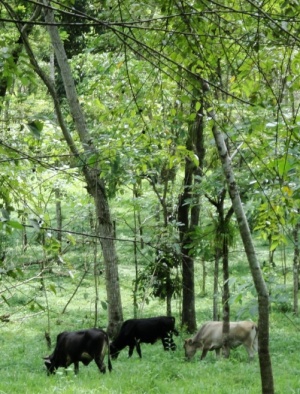
Share
Authors/Partners
World Bank
Lessons Learned from an Agro-Silvo-Pastoral Technology Transfer from Costa Rica to Cameroon
CHALLENGE
A World Bank-supported pilot project has demonstrated that several agrosilvopastoral technology innovations and systems developed and/or tested in Central America can be adapted to the Tugi (Gutah) Hills in the North West Region of Cameroon, resulting in the rehabilitation of degraded pasture lands, improved livestock productivity, increased income of the rural communities and reduced risk and vulnerability to climate change.
The challenge now is to capture some of the lessons learned during the course of the Tugi Silvopastoral Project (TUSIP), a piloted South‐South Knowledge Transfer Cooperation between the Tropical Agriculture Research and Higher Education Centre (CATIE), based in Costa Rica, and Akwi Memorial Foundation (AMF) - an NGO based in the North West Region of Cameroon, launched in January 2011.
For example, a gender mainstreaming component initiated in the second semester of the pilot to promote gender inclusion and avert the inherent gender-related “inequality of opportunity”, has demonstrated the relevance of incorporating village women groups, not only to participate in the implementation of agrosilvopastoral technology innovations, but more importantly to implement activities that respond more directly to their need for economic production and financial empowerment. The gender mainstreaming has created an environment for harmonious crop-tree-livestock integration whereby food crops, economic trees, and livestock are raised in association to promote the livelihoods of farm families.
APPROACH
The successful rehabilitation of degraded lands and the intensification of crop-tree-livestock production systems in the project area is key to securing sustained food security and other livelihoods for the targeted farmer. The agro-silvo-pastoral technologies and innovations tested in the project area will build capacity for the farmers and introduce them to environmental services and strategies to cope with climate change. The success of the pilot also hinges on the appropriate implementation of value-chain approaches to better articulate agro-forestry as one of the way farmers and their organizations will reach niche markets. The 21 months of project implementation have generated concrete results from which lessons can be learned and disseminated for knowledge sharing, replication, and scaling up/out.
This activity will help:
- collect, collate, and document lessons learned from the pilot;
- and develop and implement a dissemination strategy that will convey the lessons learned to a wide and diversified group of stakeholders. This information will be useful to guide future south-south knowledge transfers that involve the grassroots and to explore potential donors for scaling up the pilot program.
RESULTS
This activity is ongoing. Findings will be shared on this page when they become available.
For stories and updates on related activities, follow us on twitter and facebook , or subscribe to our mailing list for regular updates.
Author : World Bank
Last Updated : 06-16-2024
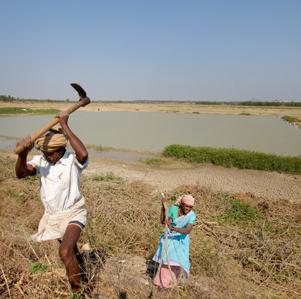
Share
Related Links
Karnataka tank project (slideshow)
Karnataka Watershed Project factsheet
Integrated Watershed Development Project
Authors/Partners
World Bank in India
Lessons from Indian Watershed Management Projects
CHALLENGE
What lessons can other countries of the world learn from successful examples of integrated watershed management in arid zones, rain-fed lowlands, and higher elevation sites in India?
- The three projects have demonstrated that a fully staffed and equipped Project Management Unit (PMU) is necessary for smooth and effective management of an integrated watershed-based livelihoods project. Such personnel should be adequately trained and retained for at least 3 years. This is not the duration of the project but this is an optimum time period for the personnel to have an effective tenure since it takes time to understand the project and be effective in the field.
- A micro project (sub-watershed level or micro-watershed level) should be planned for at least 5-7 years in order that sufficient social capital is built up. It takes time and close accompaniment to develop vibrant and representative local institutions which are most necessary to ensure continued maintenance of created assets in the post project period.
- Capacity building is crucial for sustainable outcomes to be achieved and progressed. And it should be comprehensive, progressively undertaken and involving all stakeholders in accordance with their requirements.
- Performance based payments systems, in order to be effective, must involve all stakeholders in their design and formulation and should be fairly administered, transparent, and sensitive to emergent and unanticipated events. All parties to the agreement, including government functionaries, should be held equally responsible and accountable. Since disputes will inevitably arise, there should be a conflict mediation mechanism set up at all the relevant levels coinciding with the introduction of such a payment system. In order to reduce discretion and arbitrariness, the system should be supported by an IT-enabled Decision Support System introduced at all decision making various levels.
- The manner in which agency personnel interact with the community sets the tone for the project and determines its outcome. Respect, commitment and integrity bring forth enthusiasm, cooperation, and transparency from the community. However, for this dynamic to be realized at the field level, it must also permeate the entire delivery structure and mechanism of the project. One can expect participatory processes at the village level only if the underlying values and behavioral patterns of the entire project delivery mechanism, from the higher to lower levels, reflect mutual respect and inclusion. A participation-based project must be sensitive to this aspect and make special efforts to inculcate these values into its procedures, interactions and "way of doing business".
- Transparency and public accountability, especially in regard to works and monies, is the key to smooth implementation and harmonious social relations. As the post project impact study of Sujala (this study was conducted for Karnataka as part of the ICR in late 2003) has indicated, all CBOs that have continued to function effectively post project have consistently re-affirmed that is the transparent functioning and accountability of all members of the group, especially the leaders, that have kept the groups together and functioning.
- Effective conflict resolution mechanisms that are representative and respected by the community or related stakeholders have to be established at all levels to handle disputes and complaints that often do arise. They should be perceived as responsive, transparent and fair in functioning.
- The inclusion, empowerment and mainstreaming of women, the poor and vulnerable groups in the decision making processes of the project as well as in the institutional life of the village is not only a moral imperative, but also crucial to the sustainability of the project. Generally, these groups draw upon common pool resources for their survival and unless they directly benefit from the development of these resources, they will have no incentive to protect or sustainably manage these assets. Furthermore, as income or quality-of- life enhancing benefits increasingly accrue to all groups in a community, especially the poor, not only is social capital enhanced, but the economic, cultural and political life of a community also improves.
- Networking and linking the village with local developmental agencies (civil society, government, private agencies) is vital for value addition as well as for continued accessing of additional resources in the post project period.
- Projects involving multiple agencies work best where institutional arrangements leverage the comparative advantages of each of the partners. In a situation where good NGOs are available, as in the case of the Sujala and Gramya projects, it is preferable to engage NGOs to mobilize and build the capacities of the villagers; where NGOs have the requisite technical and managerial expertise, then it is preferable to give them the entire task as they can then efficiently calibrate and dovetail various aspects of a project and be held accountable for outcomes, not just deliverables as would normally be the case where responsibilities pertain only to specified components. This would leave project authorities free to focus on monitoring and overall management of the project.
For stories and updates on related activities, follow us on twitter and facebook , or subscribe to our mailing list for regular updates.
Author : World Bank in India
Last Updated : 06-16-2024
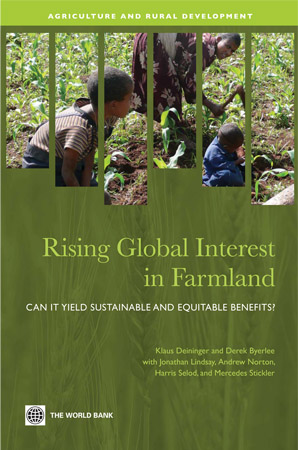
Share
Related Links
World Bank feature story on the report
External Related Links
Seven Principles for Ensuring Responsible Agro-investments
New York Times story: African Farmers Displaced as Investors Move In (12/21/2010)
Attachments
RisingGlobalInterestinFarmland-WB-2011_0.pdf
Authors/Partners
The report was prepared by a team led by Klaus Deininger, World Bank. Support was provided by PROFOR , the Swiss Agency for Cooperation and Development (SDC), the Trust Fund for Environmentally and Socially Sustainable Development (TF-ESSD), the Hewlett Foundation, the Bank Netherlands Partnership Program (BNPP) and the French Ministry of Foreign and European Affairs.
Large-scale Acquisition of Land Rights for Agricultural or Natural Resource-based Use
CHALLENGE
Large-scale land acquisition and investments in agriculture attracted considerable interest in the wake of the 2007-08 commodity boom and the subsequent financial crisis. Some countries were concerned about their inability to provide food security from domestic resources. Other investors sought land as a hedge against inflation or for speculative gain. Agro-industrial investors had an incentive to increase the scale of their operations.
This global 'land rush' is unlikely to slow given volatile global commodity prices, demand for biofuels, rising incomes, urbanization and population increases. However, opinions about the social and environmental implications of this phenomenon are divided in the absence of solid empirical data. Some have saluted the rediscovery of agriculture by different investors as an opportunity for yield increases and rural development. Others focused on highly publicized cases where land acquisition by outsiders for speculative purposes at very low prices were detrimental to local welfare, trampled basic rights and resulted in irreversible environmental damage including water pollution and deforestation.
Released in draft form in September 2010 and in hard copy in January 2011, the study Rising Global Interest in Farmland --Can it yield sustainable and equitable benefits? compiles country inventories of large land transfers during 2004-09 in 14 countries, identifies global drivers of land supply and demand and highlights how country policies affect land use, household welfare and distributional outcomes at the local level. It establishes a typology, classifying countries by the size of suitable available land and yield gaps and proposes paths for responsible agricultural investments that would contribute to positive social, economic and environmental outcomes.
MAIN FINDINGS
What emerged is a mixed picture.
- The projected increase in the demand for agricultural commodities over the next decade could be met by increasing productivity without expanding into forested areas. In particular, crop yields in the Sub-Saharan African countries which are of most interest to investors seldom exceed 30 percent of potential yields on currently cultivated areas.
- Some countries work with smallholders and use competitive bidding to foster investment deals that benefit locals. But many countries are ill-equipped to deal with large-scale land acquisition. For example, in many countries, lack of information and transparency make it difficult to exercise due diligence and responsibly manage a valuable asset. This information gap makes it easy to neglect local people’s rights and environmental impacts, opens the door to bad governance and corruption and jeopardizes investors’ tenure security. Furthermore, land transfers appeared mainly ad hoc based on investor demands rather than country development strategies.
- There is a large discrepancy between investments deals reported in the media and those actually finalized, and between deals signed and actual land area under cultivation. While some countries have transferred large areas to investors, the extent to which such land is actually used productively remains limited. For example, in South East Asia, in response to policies that aimed to foster development of the palm oil industry by giving away land (and the trees on it) for free, large areas with high biodiversity value have been deforested without ever having been planted to oil palm. In Mozambique, 2004-2009, 2.7 million has of land were acquired by investors, but a 2009 land audit found that some 50 percent of this land was unused or not fully used. Many projects in the biofuel sector experienced problems or were cancelled due to lower oil prices. Beyond economic and technical challenges, tensions with local communities have often stymied implementation.
- Case studies based on field visits show that investments can bring significant benefits under certain conditions but that the benefits are often outweighed by negative impacts borne disproportionately by vulnerable groups. Even projects that are not fully implemented can seriously undermine local livelihoods. Project proposals that were not implemented have often affected patterns of resource access and shifted the local balance of power. Expressions or expectations of outside interest in agricultural land can set in motion “land grabbing” by local elites that can have undesirable social impacts or deprive vulnerable people of their livelihoods.
RESULTS
- Building upon this study’s initial results and consultations with governments and private sector investors, the Bank drafted seven principles for ensuring responsible agro-investments: Respecting land and resource rights; Ensuring food security; Ensuring transparency, good governance, and a proper enabling environment; Consultation and participation; Responsible agro-investing, Social sustainability; Environmental sustainability.
- A number of developing countries have approached the World Bank for technical assistance to improve the capacity of their legal and institutional environments to screen, monitor and enforce responsible agro-investments.
For stories and updates on related activities, follow us on twitter and facebook , or subscribe to our mailing list for regular updates.
Author : The report was prepared by a team led by Klaus Deininger, World Bank. Support was provided by PROFOR , the Swiss Agency for Cooperation and Development (SDC), the Trust Fund for Environmentally and Socially Sustainable Development (TF-ESSD), the Hewlett Foundation, the Bank Netherlands Partnership Program (BNPP) and the French Ministry of Foreign and European Affairs.
Last Updated : 06-16-2024
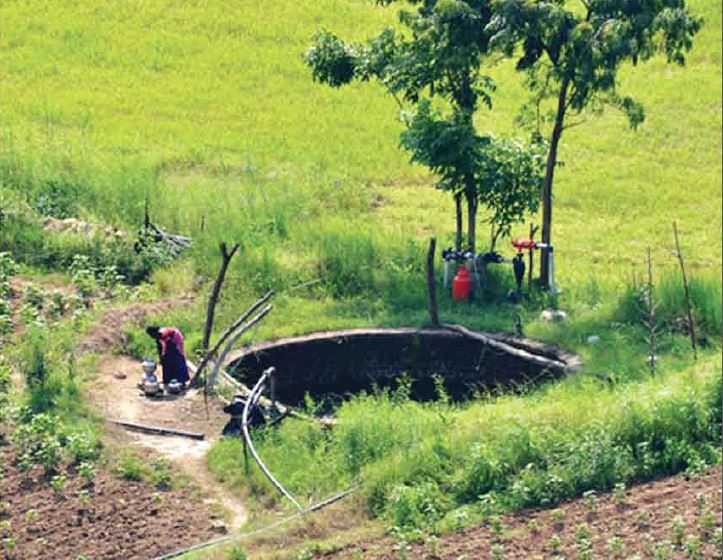
Share
Related Links
Watershed development in India: Case study summary
Attachments
Watershed Development in India An Approach Evolving through Experience_0.pdf
Volume II-Annexes Catchment Assessment and Planning for Watershed Management_0.pdf
Volume I-Main Report Catchment Assessment and Planning for Watershed Management_0.pdf
Summary Report Catchment Assessment and Planning for Watershed Management_0.pdf
Authors/Partners
World Bank
Institutional Analysis and Landscape Level Planning Guidelines for Watershed Development in India
CHALLENGE
Improved watershed management will be crucial to meet growing food demand in India, for example by: recharging local aquifers and improving downstream water flows; decreasing soil erosion; increasing agricultural productivity; and helping farmers adapt to climate change. Experts believe that an additional 102 million tons of food grains need to be produced annually by 2020 to meet national nutritional needs under moderate population growth forecasts, 38 million tons of which will need to come from either rainfed lands or imports.
However, rainfed regions have lagged far behind and have experienced severe resource degradation due to inappropriate land use, poor husbandry and low investments. Longer-term climate change adds another worrying dimension. Climate change requires new adaptation measures by farmers, especially small and marginal farmers who are the most vulnerable to these forecast impacts.
The Integrated Watershed Management Program (IWMP), financed through the Department of Land Resources, currently forms the cornerstone of the Government of India's support to watershed development, covering 27 states and proposing to invest over US$6.6 billion through a 10-year period to 2017. Besides the IWMP, a number of other centrally financed schemes are related to watershed management, agriculture and rural livelihoods, which to varying degrees address development needs in rainfed areas. The IWMP has been slowly rolling out and expanding its reach across India since 2009. But, it has not delivered expected results evenly across the country or to the desired levels. In moving forward to improve the IWMP model and execution, a number of key issues outlined recently by the Planning Commission and various other reports/experts have been identified.
Two key issues are:
Fragmented programming and partial solutions. Given their ecological characteristics, developing rainfed areas requires a broad watershed approach. Large budgets are now available for IWMP and several other schemes for the development of rainfed areas within the Ministry of Rural Development. However, each of these is conceived and implemented in departmental silos without unified mechanisms for coordination and convergence. As a result, these programs do not lead to area development, potential synergies are lost, and investments, interventions, and results remain sub-optimal.
Narrow planning scale. The IWMP is executed through clusters of micro-watersheds (each usually 500 ha to 700 ha) covering an average of 5,000 ha. This scale is appropriate for participatory planning and implementation communities. However, a larger landscape assessment/planning framework ranging up to 25,000 ha is also needed where broader land and water issues can be identified, and a more coordinated approach developed to converge government schemes with the IWMP. The current IWMP model also does not fully incorporate surface and groundwater assessments into management and monitoring activities to guide integrated planning at sub-watershed and micro-watershed scales.
APPROACH
This activity aims to address some of the issues above by helping to:
- Improve intra- and inter-ministerial convergence in watershed management in India;
- Develop landscape level catchment assessment/planning methods and guidelines for India; and
- Disseminate knowledge on good practices in watershed management building on a draft report prepared under a previous PROFOR activity.
RESULTS
The activity was successfully completed. The final report “Catchment Assessment and Planning for Watershed Management” is now available to the left along with a summary report. A launch workshop was held in Washington, D.C., in October 2014. A similar workshop was held in Delhi in December 2014. One article based on this work was published in a national journal in India. In addition, the “Operational Guidelines for Benchmarking Watershed Management Outcomes” prepared by the Ministry of Rural Development of India and the World Bank discussion paper “Watershed Development in India: An Approach Evolving through Experience” can be downloaded from this page.
Some key insights and lessons are:
- Micro-watersheds are the appropriate scale for program implementation with communities, with guidance by larger scale catchment assessments.
- Decentralized and participatory development is a necessary approach for success.
- Invest in participatory, evidence-based micro-watershed plans with communities.
- Invest in capacity building and information sharing to build sustainability and a body of knowledge.
- Invest in comprehensive monitoring and evaluation (M&E) to track implementation and support management.
For stories and updates on related activities, follow us on twitter and facebook , or subscribe to our mailing list for regular updates.
Author : World Bank
Last Updated : 06-16-2024
Share
Attachments
Authors/Partners
World Bank Middle East North Africa Region, IFPRI
Implications of the Changes in Agro-food and Fuel Prices on Rural Livelihoods and Forests in Syria
CHALLENGE
More than 60 percent of Syria’s poor people live in rural areas and more than half of these depend on agriculture for their livelihood. The country’s forests, which include 23 natural protected areas rich in biodiversity, also represent a significant source of livelihoods for rural populations. But these protected areas are feeling the strains of overuse and degradation from human activity such as overgrazing, overexploitation of wood, and expansion of agriculture.
In this context of natural resource dependence, it is conceivable that the post-2006 increase in the prices of agro-food products has had a significant direct impact (through their influence on farming costs and revenues) and indirect impact (by affecting other potential sources of revenues such as tourism, and sales of handicrafts to tourists) on rural livelihoods.
But as yet, the impact of increased agro-food and fuel prices on farmers and on forest use is not clear. To the extent that a change in agricultural activities compete with forests, pressure on forests may have risen (eg. increased overgrazing).
APPROACH
In order to guide the World Bank and development partners' support to Syria’s natural resource management, PROFOR supported a knowledge activity examining the implications of recent changes in international and local agro-food and fuel prices on farmers’ welfare (and rural livelihoods more broadly) and on their use of forests. In response to requests form the Government of Syria, the analysis also addressed critical challenges facing the development of the rural sector in a changing climate.
RESULTS
This activity was closed in December 2011.
- Robert Wilby of Loughborough University has produced a report with climate risk information by down-scaling historical climate data and projected climate scenarios for Syria at a detailed spatial scale for year 2030, 2050 and 2100.
- IFPRI was hired to produce an economy-wide impact assessment of climate change on the rural sector by integrating biophysical data in a general equilibrium model. A seminar was held with the State Planning Commission and NAPC on the economic modeling part of the CC analysis in September, 2010. The discussion paper "Global and Local Economic Impacts of Climate Change in Syria and Options for Adaptation" is available here.
- A World Bank Policy Note on Climate Change in Syria was submitted in October, 2010 to the State Planning Commission as input for the next 5-year plan.
- However, since February 2011, the political crisis in Syria has prevented World Bank staff and consultants from traveling to Syria. Therefore the qualitative field work, training and consultations planned under this activity were not undertaken.
For stories and updates on related activities, follow us on twitter and facebook , or subscribe to our mailing list for regular updates.
Author : World Bank Middle East North Africa Region, IFPRI
Last Updated : 06-16-2024
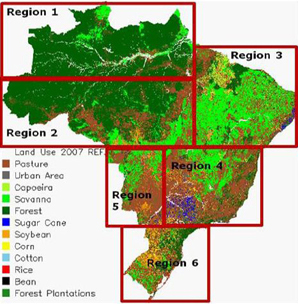
Share
External Related Links
The Economics of Climate Change in LAC (2010)
Attachments
web%20brasil_2030_portugues_0.pdf
Authors/Partners
A multidisciplinary and multi-agency team comprising leading experts from the Brazilian National Agricultural and Forestry Research Agency (EMBRAPA), the University of Campinas (UNICAMP) in Sao Paulo, the Brazilian Agency for Space Research (INPE), and the Brazilian Institute for International Trade Negotiations (ICONE), a major think-tank.Erick Fernandes, Adviser, Climate Change and Natural Resource Management, World Bank (Latin America and Caribbean), managed and oversaw the program.
Impacts of Climate Change on Rural Landscapes in Brazil
CHALLENGE
There is growing concern that Brazilian agriculture and forestry sectors are increasingly vulnerable to climate variability and change (eg. a decline in productivity of subsistence crops in northeastern Brazil; increased risk of fire and Amazonian forest dieback). To meet development, food security, climate adaptation and mitigation, and trade goals over the next several decades, Brazil will need to significantly increase per area productivity of food and pasture systems in central and southern Brazil while simultaneously reducing deforestation, rehabilitating millions of hectares of degraded land for cropping and forest plantations in the Amazon, the cerrado, the Atlantic forest, and the Pampas.
However, because of previous climate modeling and data limitations, there was still significant uncertainty associated with the projections for Amazonian rainfall (timing, seasonality) as well as the magnitude and locations of climate impacts in Brazil over the next 50 years. Improved climate change impact assessments were urgently needed to guide policy makers on priorities, geographical targeting (hot spots), and phasing of investments for adataptation and mitigation to climate change.
APPROACH
This activity implemented by the World Bank in partnership with leading Brazilian agencies and supported by PROFOR focused on establishing a robust and integrated decision and policy support framework that could empower Brazil’s policy makers and the agricultural sector to undertake the adaptation necessary to cope with projected climate change.
Its objectives were:
- 1.To refine the available climate change projections for Brazil via the coupling of global, regional, and local scale modeling currently being tested by the Brazilian National Institute for Space Research (INPE) in Brazil and the regional climate program for South America (CREAS).
- 2. To integrate the INPE and CREAS suite of tested global (300 km horizontal resolution) and regional models (50 km horizontal resolution) with the state of the art Brazilian developments in Regional Atmospheric Model (BRAMS) that incorporates aerosol and land cover/deforestation/burning feedbacks for much improved local weather and climate (especially rainfall) projections.
- 3. To make the Brazilian Agro-Eco Zoning Model that is currently used by the Central Bank of Brazil for rural credit programs "climate-smart" by integrating the high resolution climate projection outputs from 1 and 2.
- 4. To make the existing Brazilian Land Use Model (BLUM) climate-sensitive by coupling it with the outputs described above to assess: (a) Climate change induced changes in supply and demand of agricultural commodities at a national level, (b) Changes on the distribution of land use and production (agriculture, forestry, pasture) in Brazil for given supply and demand scenarios, and (c) Economic effects on agricultural and forestry production and profitability.
RESULTS
Projections for land use and forest land cover change, and an assessment of the distribution of land use and production were undertaken. Specifically, previous climate change projections were refined using a global, regional and local scale modeling; Regional Climate Change Scenarios for South America (CREAS) were used for regional and sectoral impact assessments; the Agro Climatic Risk and Vulnerability Zoning Model developed by EMBRAPA and UNICAMP was refined; soils were classified and cropping areas that are less vulnerable to climate change impacts were identified based on temperature effects through 2020 and 2030. A final report, in English and Portuguese, is forthcoming.
FINDINGS
The study showed that while for some crops (soybean and cotton) the projected negative climate impacts to 2020 are likely to be more moderate than previously projected, for other crops (beans and corn), however, the impacts could be significantly more severe than projected in previous studies. All the climate change scenarios simulated in this study resulted in a reduction of ‘low risk’ cropland area in 2020 and 2030.
More specifically, the findings suggested that the South Region of Brazil, currently an agricultural powerhouse, could potentially lose up to 5 million hectares (ha) of its highly suitable agricultural land due to climate change, while Brazil as a whole could have around 11 million ha less of highly suitable agricultural land by 2030. The findings of this study are being incorporated by EMBRAPA into the EMBRAPA/UNICAMP Agroecozone Model to improve the climate projections that underpin the national rural credit and insurance programs in Brazil.
Read the report in Portuguese.
Follow us on twitter and facebook or join our mailing list for regular updates.
For stories and updates on related activities, follow us on twitter and facebook , or subscribe to our mailing list for regular updates.
Author : A multidisciplinary and multi-agency team comprising leading experts from the Brazilian National Agricultural and Forestry Research Agency (EMBRAPA), the University of Campinas (UNICAMP) in Sao Paulo, the Brazilian Agency for Space Research (INPE), and the Brazilian Institute for International Trade Negotiations (ICONE), a major think-tank.Erick Fernandes, Adviser, Climate Change and Natural Resource Management, World Bank (Latin America and Caribbean), managed and oversaw the program.
Last Updated : 06-16-2024
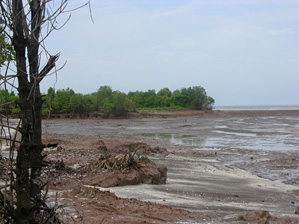
Share
External Related Links
Documentary on Rwanda's efforts to plan for climate change (John Liu, hosted on Youtube)
CIFOR Blog: Adaptation research needed to fill gaps
Attachments
Uso de los bosques para aumentar la capacidad de adaptación al cambio climático _0.pdf
PROFOR_Brief_HondurasLow_0.pdf
PROFOR_WrkingPaper_Honduras_0.pdf
PROFOR_Brief_Honduras_ESP (00000003)_0.pdf
Country case study - Burkina Faso_0.pdf
Authors/Partners
CIFOR, Trust Fund for Environmentally and Socially Sustainable Development, PROFOR
How Forests Enhance Resilience to Climate Change
CHALLENGE
Developing countries are expected to suffer the most from changes in climatic patterns. The effects of climate change, including higher temperatures, changes in precipitation patterns, rising sea levels and increased frequency of weather related disasters are bound to create risks for agriculture, food, and water supplies. International and national discussions on forests and climate change have largely been focused on reducing emissions from deforestation and degradation and enhancing carbon stocks (REDD+).
Less obvious, yet equally important, is the role of forests in enhancing landscape resilience to climate change—for example at the scale of a watershed. Forests and trees provide environmental services ranging from increasing water quality and quantity in well defined areas, reducing soil erosion, creating micro-climatic conditions that maintain (or in some cases improve) productivity. The sustainable management of forests can also strengthen social resilience, by offering a diversification of revenue sources and product supplies, and building the capacity of local and national institutions.
Forest and tree management could provide a low-cost approach to enhancing resilience of local landscapes to climate change but needs to balance production, livelihood, adaptation and mitigation goals.
PROFOR is conducting a study to improve our understanding of the role of forests in improving the climate resilience of other sectors (mainly agriculture, water, social and biomass based energy sectors). The goal is to inform national adaptation strategies so that they explicitly reflect the value of forest and allocate appropriate resources to facilitate the use of forests for adaptation.
This study will:
• Map forest management approaches and their cross-sectoral impacts
• Identify interactions between forest sector adaptation (or existing management) and resilience enhancement in other sectors (mainly water, biomass-based energy, and agriculture)
• Assess the institutional and financial requirements to identify and implement tree/forest-based adaptation measures
• Identify ways of supporting local knowledge and science that promote tree/forest based adaptation measures with multi-sectoral benefits
RESULTS
The state of knowledge report, synthesis report and case studies are now complete. Briefs for each case study will be available for download soon (the Honduras case study is already available at left in English and Spanish.
For stories and updates on related activities, follow us on twitter and facebook , or subscribe to our mailing list for regular updates.
Author : CIFOR, Trust Fund for Environmentally and Socially Sustainable Development, PROFOR
Last Updated : 06-15-2024
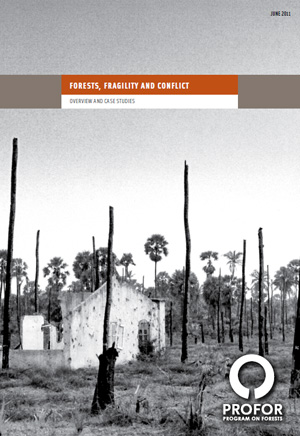
Share
Related Links
Supporting the Development of Liberia's Chain of Custody System
External Related Links
World Development Report 2011 on conflict, security and development
Attachments
FRAGILE%20FOREST_Final_WebRes_0.pdf
Authors/Partners
Emily Harwell (lead consultant), with Arthur Blundell and Douglas Farah
Forests, Fragility and Conflict
CHALLENGE
An emerging body of analytic work has demonstrated the linkage between poverty, armed conflict, and weak state governance. States which exemplify this nexus of human vulnerability and state failure are often referred to as ‘fragile states’-- those failing, whether for lack of capacity or political will, to perform core functions of delivering basic services and protecting the security of its citizens.
There are strong correlations between state fragility, conflict, and the means by which natural resources such as forests are managed by the state. When resource rents and concession allocations are used for patronage it has the perverse effect of not only undermining the sustainable use of forest assets for development and access to forests for local livelihoods, but it also short-circuits state accountability to citizens and the development of sound governance institutions, laying the foundations for state fragility and conflict.
- the impact of conflict and fragility on forests, with a special focus on cross-sectoral post-conflict issues associated with the management of forest resources,
- the mechanisms and channels of financial flows from forest extraction to state and non-state belligerents, which thereby facilitate or prolong conflict, and
- the characteristics of fragile states that should be the focus of reform in post-conflict interventions in order to improve protection of forests and forest-based livelihoods and to mitigate further conflict.
RESULTS
The synthesis report informed some of the thinking that went into the World Development Report on Conflict, Security and Development, available here.
The synthesis and case studies, published as a collection in June 2011, are available on this page.
The hope is that this publication will contribute to the articulation of a strategic approach to dealing with forest management in post-conflict operations.
For stories and updates on related activities, follow us on twitter and facebook , or subscribe to our mailing list for regular updates.
Author : Emily Harwell (lead consultant), with Arthur Blundell and Douglas Farah
Last Updated : 06-15-2024
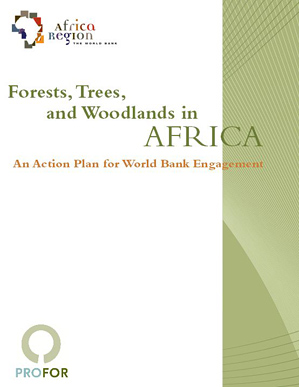
Share
Related Links
Attachments
Africa-Forests-Trees-ActionPlan_0_0.pdf
Authors/Partners
World Bank Africa Region
Forests in Sub-Saharan Africa: Challenges & Opportunities
CHALLENGE
More than 70 percent of the population in Sub-Saharan Africa depends on forests and woodlands for its livelihood; one fifth of rural families’ daily needs come from forests. Woodlands and forests supply approximately 60 percent of all energy. Forest-related activities accounts for a large part of the GDP of most of the continent’s countries. And, Africa is home to 25 percent of the world’s remaining rainforests.
Despite significant international financial support to the forestry sector in the Sub-Saharan African countries, impacts on sustainable management and poverty alleviation are still below expectations.
APPROACH
PROFOR support to the World Bank’s Africa region sought to meet the need for a more comprehensive approach to tackling forest-related challenges and proposing solutions. This approach could help countries better incorporate forestry issues into overall development policy, identify priority actions, and help donors/partners who support development and forestry in Africa coordinate and finance programs more strategically.
PROFOR funding supported:
- A review of forestry documentation on Sub-Saharan Africa.
- Identification of challenges and issues in sub-regions, with an emphasis on obtaining lessons from past successes or failures.
- Identification of recommended options with an Action Plan; roles and responsibilities; partners and if possible indications of required financing.
- Coordination among development partners (multilateral and bilateral).
RESULTS
Findings from this activity were incorporated in Forest, trees, and woodlands in Africa : an action plan for World Bank engagement (June 2012). The report lays out 7 action areas, which involve policy measures, increased investments and a greater push for sound governance to better manage forests:
- Sustainable protection and development for wood-fuel and charcoal industries to serve domestic (and potentially export) markets;
- Landscape and watershed restoration, including planting trees and the development of policy measures to prevent future and mitigate past damages from mining investments;
- Plantation management to support a range of timber products in addition to wood-fuel including poles for construction and electricity transmission lines and furniture;
- Reforms and incentives in the domestic timber industry to reduce waste and support legal timber operators;
- Increased management planning, development, and financing for protected areas, community-based resource management and eco-tourism;
- Improved forest sales management in heavily forested countries
- Development of REDD+ (reduced emissions from deforestation and forest degradation) programs and carbon finance to help countries capture potential revenues from the carbon storing value of forests and promote co-benefits with communities through landscape restoration and reforestation projects.
Because of the geographic and climatic diversity in Africa, these action areas are adapted for the specific environmental challenges in each sub-region region (Sahel, humid West Africa, Central Africa, Eastern Africa, Southern Africa).
The report stresses that there is an urgent need to improve the availability and quality of information, especially statistical data, surrounding forests and woodlands. Mobile phones and other Information Communications and Technology are already being used to improve the collection and dissemination of forest data, including real-time fire alerts, game density mapping, and verification for legal timber operations.
For stories and updates on related activities, follow us on twitter and facebook , or subscribe to our mailing list for regular updates.
Author : World Bank Africa Region
Last Updated : 06-15-2024
Share
Related Links
Global Partnership on Forest Landscape Restoration
Attachments
Ghana national landcover map_0.pdf
Ghana FLR PRESENTATION PROFOR_0.pdf
Ghana FLR PROFOR final report 29 September_0.pdf
Authors/Partners
IUCN, PROFOR, DFID, World Bank
Forest Landscape Restoration: Ghana
Assessment of forest landscape restoration potential in Ghana to contribute to REDD+ strategies for climate change mitigation, poverty alleviation and sustainable forest management
CHALLENGE
The negotiations on mitigating climate change have moved from a narrow focus on avoided deforestation to a broader approach to reduced emissions called "REDD+". The "plus" encompasses conservation, sustainable management of forests and enhancement of forest carbon stocks. The importance of forest landscape restoration in addressing climate change and other societal needs was brought home in November 2009 when the Global Partnership on Forest Landscape Restoration (GPFLR) concluded that more than 1 billion hectares of lost forests and degraded lands worldwide present restoration opportunities that could sequester significant amounts of carbon.
Ghana, a country where gradual degradation is more of a threat to tree cover than outright deforestation, is eager to assess and harness the potential of forest landscape restoration. It is an active participant in the Forest Carbon Partnership Facility (FCPF) and was chosen as a pilot country for the Forest Investment Program (FIP).
APPROACH
With support from PROFOR, IUCN and the UK government, the World Bank's Africa region lead the following analytical work in partnership with the GPFLR:
- Preliminary national assessment of forest landscape restoration (FLR) potential, including mapping, assessment of carbon potential and economic analysis
- Development of recommendations on the contribution of FLR within the national and global REDD+ debate and identification of opportunities for investment
- Development and dissemination of a methodology that could benefit other countries
The project was carried out in a participatory manner to ensure that the analysis is credible and has the support of multiple stake-holders.
RESULTS
The activity produced forest reserve cover maps indicating whether the forests are degraded or not, but did not deliver an assessment of the potential for forest landscape restoration nationwide. There was a strong interest in Ghana in assessing the degradation status of the forest reserves against a 1995 baseline. There was also an opportunity to gain experience comparing remotely sensed and ground-based information that could later be extended to other parts of the country.
The project generated a methodology for assessing forest degradation in Ghana as well as information showing that significant degradation had indeed taken place since the last systematic assessment carried out by Hawthorne and Abu-Juam in 1995.
The methodology for assessing forest degradation involved:
- Image acquisition and pre-processing (Landsat data between 1999 and 2010)
- Image classification (using Iterative Self-Organizing Data Analysis) and field validation to assess mapping accuracy
- Map composition and presentation
After the end of the PROFOR grant in September 2011, the work on forest landscape restoration assessment continued under the German-funded International Climate Initiative.
For stories and updates on related activities, follow us on twitter and facebook , or subscribe to our mailing list for regular updates.
Author : IUCN, PROFOR, DFID, World Bank
Last Updated : 06-15-2024








